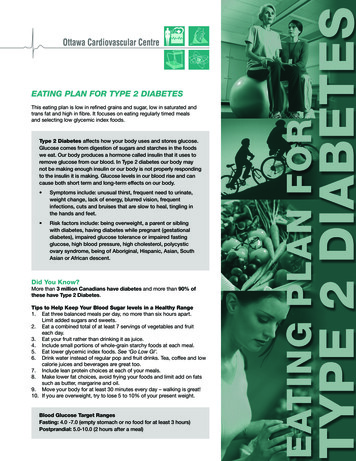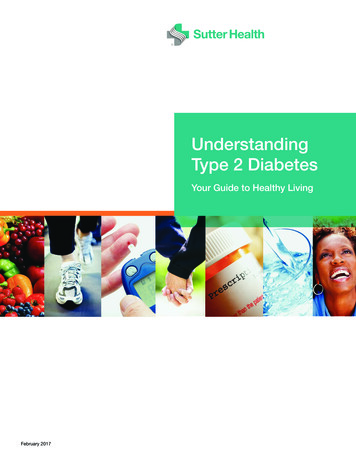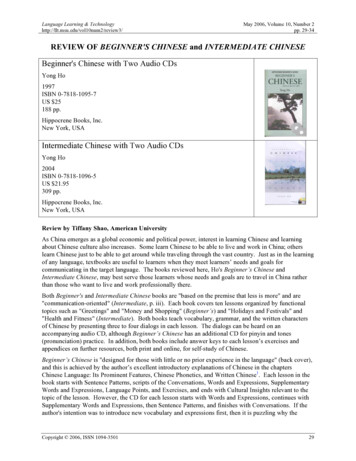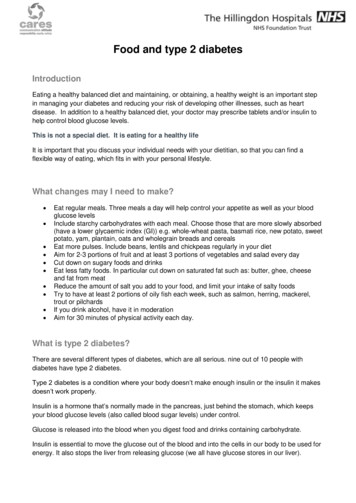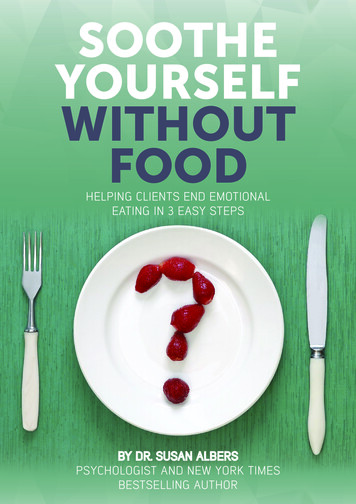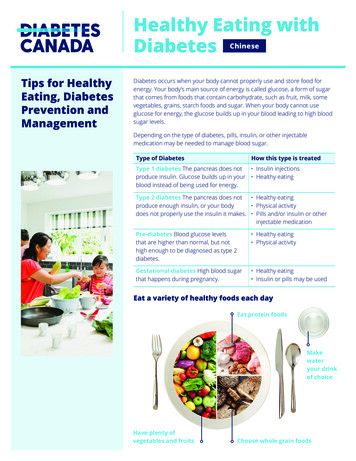
Transcription
Healthy Eating withDiabetesChineseTips for HealthyEating, DiabetesPrevention andManagementDiabetes occurs when your body cannot properly use and store food forenergy. Your body’s main source of energy is called glucose, a form of sugarthat comes from foods that contain carbohydrate, such as fruit, milk, somevegetables, grains, starch foods and sugar. When your body cannot useglucose for energy, the glucose builds up in your blood leading to high bloodsugar levels.Depending on the type of diabetes, pills, insulin, or other injectablemedication may be needed to manage blood sugar.Type of DiabetesHow this type is treatedType 1 diabetes The pancreas does not Insulin injectionsproduce insulin. Glucose builds up in your Healthy eatingblood instead of being used for energy.Type 2 diabetes The pancreas does not Healthy eatingproduce enough insulin, or your body Physical activitydoes not properly use the insulin it makes. Pills and/or insulin or otherinjectable medicationPre-diabetes Blood glucose levelsthat are higher than normal, but nothigh enough to be diagnosed as type 2diabetes. Healthy eating Physical activityGestational diabetes High blood sugarthat happens during pregnancy. Healthy eating Insulin or pills may be usedEat a variety of healthy foods each dayEat protein foodsMakewateryour drinkof choiceHave plenty ofvegetables and fruitsChoose whole grain foods
Even if someone is taking diabetes medications, all types of diabetes aremanaged better with healthy eating. Knowing what to eat and how much toeat will help you manage your blood sugar levels. E at more vegetables (bok choy, broccoli). These are very high in nutrientsand low in calories. Choose lean animal proteins such as fish, chicken, lean meats, low-fatcheese, or eggs. Select more vegetable protein like tofu. Select plant oils such as olive and canola, and nuts instead of animal fatsand coconut oil. Eat small portions of grains and starches including whole grain breads,congee; rice (brown, white, parboiled), or noodles at each meal. Have plain yogurt and a piece of fruit to complete your meal.Handy portion guideYour hands can be very useful in estimating the right amount of food to eat.When you are planning a meal, use the following portion sizes as a guide:Fruits/Grains & StarchesExamples:Fruits, rice, noodles, oats, congeeFruits/Grains & StarchesChoose an amount the size of yourfist for grains or starches, or fruit.VegetablesChoose as much as you canhold in both hands. Choosebrightly coloured vegetables.VegetablesExamples:Bok choy, choy sum, mushrooms,broccoli, cabbageProtein FoodsTofu, lean beef, poultry, fish,yogurt, milk (1% or skim), fortifiedsoy beverageFatsExamples:Non-hydrogenated margarine,canola oil, olive oil, peanut oilProtein FoodsChoose an amount the size ofthe palm of your hand and thethickness of your little finger.FatsLimit fat to an amount the sizeof the tip of your thumb.
Sample Meal PlansChinese StyleWestern StyleBreakfast: Rice vermicelli or macaroni in chicken broth (1 cup, 250 mL)* measured after cooking Lean meat (1 oz, 30 g) Choy sum Fortified soy beverage (unsweetened or with artificialsweetener) 1 cup, 250 mLBreakfast: Oatmeal (1/2 cup, 125 mL)* measured after cooking Whole grain toast (1 slice) 1 Orange Low-fat milk or fortified soy beverage (1 cup, 250mL) Peanut butter (2 tablespoons, 30 mL) Tea or CoffeeLunch: Noodles (1 cup, 250 mL)* measured after cooking Lean meat (2 oz, 60 g) With Broth VegetablesOR Stir-fried tofu with mixed vegetable (3/4 cup, 150 g tofu) Brown rice (2/3 cup, 150 mL) 1 Medium apple Hot teaLunch: Sandwich2 slices whole grain bread or 6” pitalean meat, chicken or fish (2-3 oz, 60-90 g)tomato slicesnon-hydrogenated margarine (1 tsp, 5 mL) Grapes (1/2 cup, 125 mL) Low-fat plain yogurt (3/4 cup, 175 mL) Tea or coffeeDinner: Wintermelon soup Brown rice (2/3 cup, 150 mL)* measured after cooking Stir-fry broccoli with beef (1 oz, 30 g beef) Steamed fish with ginger and green onion (2 oz, 60 g fish) Stir-fried spinach with garlic Oil, small amount for stir-frying 1 Medium orange Hot teaDinner: Potato (1 medium) or Noodles (1 cup, 250 mL) Vegetables Non-hydrogenated margarine (1 tsp, 5 mL) Lean meat, chicken, or fish (2 oz, 60 g) Cantaloupe (1 cup, 250 mL) Low-fat milk (1 cup, 250 mL) Tea or coffeeEvening Snack: Fortified soy beverage (unsweetened or with artificialsweetener), 1 cup, 250 mL Unsalted mixed nuts (2 tbsp, 30 g)Evening Snack: Low fat cheese (1oz, 30 g) Whole grain crackers (4 pieces) Fortified soy beverage (unsweetened or with artificialsweetener), 1 cup, 250 mLThe sample meal plans are a guide only. See a registered dietitian for advice on making healthy food choices.
Being Well Helps You and Your FamilyHere are some tips to help you before you see a registered dietitian.When to eat?TipsWhy? Because It provides a good start to the day. Eating the right amount at the right time helps keepsyour blood glucose in balance.Be sure to eat breakfast.Eat three meals per day at regular times.Space meals no more than six hours apart.You may want to include a healthy snack. P ack healthy foods with you (such as whole graincrackers, cheese and vegetables) in case you are goingto be away from home at meal time. This helps you have healthy choices, wherever you go.What to Eat Eat a variety of foods at each meal or snack C hoosing foods from all food groups will make sure thatthe body gets all the nutrients it needs to be healthy. L imit sugars and sweets such as regular soft drinks,desserts such as nian gao, custard tarts, candies, jamand honey. Artificial sweeteners can be safe in small amounts. T he more sugar you eat or drink, the higher your bloodglucose will be. L imit high fat and greasy foods, such as fried foods,spring rolls, deep fried dim sum, donuts. Prepare foods in a healthy way, such as baking, broiling,braising, steaming, poaching, roasting, stir-frying,sautéing. H igh fat foods are hard on the heart and may causeweight gain. A healthy weight is easier for the heart and helps withblood glucose control. E at at least two different kinds of vegetables at eachmeal. V egetables are high in the nutrients the body needs tobe healthy. I nclude foods high in fibre (whole grain breads, roti,cereals, lentils, dried beans, brown rice, vegetables andfruits) Choose lower glyecmic index food more often (noodles,spaghetti, vermicelli, soba noodles) H igh fibre foods help you feel full, and lower your bloodglucose and cholesterol levels. If you are thirsty, drink water. D rinking regular pop, fruit juice, sweetened coffee andtea, will raise your blood glucose.How much to eat Eat slowly and stop when you feel full and satisfied. T he right amount of food gives your body what it needsto be healthy. If you eat too much, your body will store the extraenergy as fat. You may also gain weight by eating more than you need.
Physical activity is also a way to live well with diabetesTipsWhy? Because T ry to do some physical activity such as walking everyday R egular physical activity will improve your blood glucosecontrol. Diabetes Canada recommends 150 minutes of physicalactivity each week. You can break down the 150 minutes of physical activityinto 30 minutes, five times a week . You will also feel better in body and spirit.How to add physical activity to life?TipsExamples Build time for physical activity into your daily routine. W alking around the neighbourhood, taking the stairs,getting off the bus one stop early. Start slowly and gradually increase the amount of effort. S tart from slow walking. When you are ready, increaseyour pace. T ry to be active most days of the week. Diabetes Canada Brisk walking, raking leaves, jogging, swimming,recommends 150 minutes of moderate- to vigorousbasketball, vacuuming.intensity each week. S trength resistance exercises are recommended at least Weightlifting, push-ups, sit ups and resistance bandtwo times a week.exercises. M ake family activities active instead of watching TV orgoing to a movie. T aking a bike ride around the neighbourhood or takingthe family swimming at the local pool. Challenge yourself by trying new activities. Learn to dance, play tennis or do yoga. Be active indoors. W eightlifting, push-ups, sit ups and resistance bandexercises. Climb up and down the stairs for 10 minutesat a time or walk in a mall.
Limit alcoholconsumptionGlossaryAlcohol can affect blood glucoselevels. It can also cause you to gainweight and change how your bodyuses medicine.Talk to your healthcare team abouthow much alcohol is safe for you.Take care of your whole bodyfor a healthier life! Manage yourdiabetes in a healthy way!Looking for more information?Visit www.diabetes.caCarbohydrate Carbohydrate gives your body energy. It is found in foodslike grains (i.e. rice, noodles, congee, oats etc), fruit, milk, yogurt and starchyvegetables (i.e. potatoes, corn). Carbohydrates are broken down into glucosein your body. When you have diabetes, glucose from your food, is not usedin the right way. When it is not used in the right way, there can be too muchglucose in your blood and causing your blood glucose levels to rise higherthan it should be.Physical activity Physical activity is something that everyone can do toimprove health and well-being. It does not involve going to the gym orrunning a marathon. Physical activity can simply be walking up and down thestairs and walking around the neighborhood and doing housework such asvacuuming.Diabetes Canada recommends 150 minutes of moderate to vigorous-activityeach week. It also recommends adding resistance exercise, such as weightlifting and resistance band exercise, to your physical activity routine at leasttwo times each sources/benefits-of-physicalactivity.pdfAerobic activity Aerobic activity makes you breathe harder and your heartbeat faster.Examples include: brisk walking, skating and bike esources/maintaining-aerobicexercise.pdfResistance Exercise Resistance exercise involves brief repetitive exerciseswith weights, weight machines, resistance bands or one’s own body weight tobuild muscle t-resources/resistance-exercise.pdfdiabetes.ca 1-800 BANTING (226-8464) info@diabetes.caDiabetes Canada is making the invisible epidemic of diabetes visible and urgent. Close to 11.5 million Canadians have diabetes or prediabetes. Now is thetime to End Diabetes - its health impacts as well as the blame, shame and misinformation associated with it. Diabetes Canada partners with Canadians toEnd Diabetes through education and support services, resources for health-care professionals, advocacy to governments, schools and workplaces, and,funding research to improve treatments and find a cure.This document reflects the 2018 Diabetes Canada Clinical Practice Guidelines 2018 The Canadian Diabetes Association. The Canadian DiabetesAssociation is the registered owner of the name Diabetes Canada. 02/22
diabetes.ca 1-800 BANTING (226-8464) info@diabetes.ca Diabetes Canada is making the invisible epidemic of diabetes visible and urgent. Close to 11.5 million Canadians have diabetes or prediabetes. Now is the time to End Diabetes - its health impacts as well as the blame, shame and misinformation associated with it.

